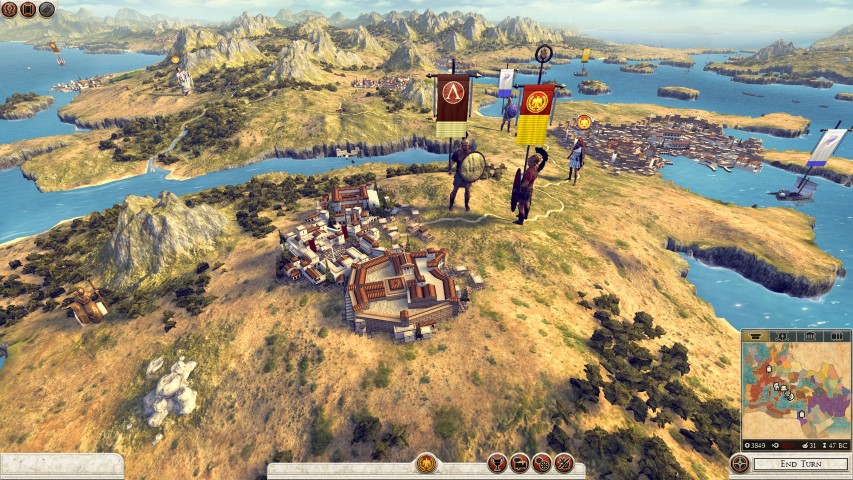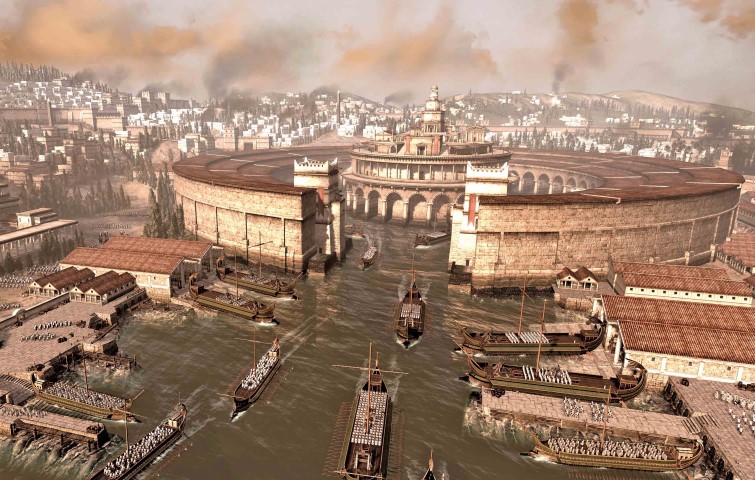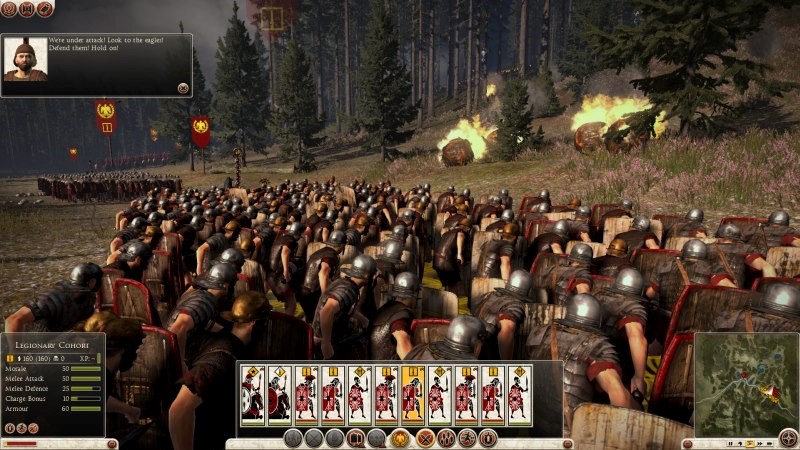|
Total War Rome II
Im not sure if having
never before played a Total War game means Im the best person to
review Creative Assemblys new Total War: Rome II, or the worst.
Past Total War releases have been intriguing, but those big
sweeping battles that seem their selling point to fans always just
intimidated me. I pictured my poor PC sweating over the graphics
requirement, and my head slowly imploding as I frantically scrolled in,
out and across the map trying to figure where my focus should be. Im
afraid Ive always been more a top-down Command & Conquer type
RTS guy. However micro-management is my thing, Im a Sid Meier
fanboy from way back, and the opportunity to play God- I mean Jupiter,
over one of my favourite eras of history was simply too tempting to pass
up.

The original Rome: Total War was released a
decade ago, so CA have had plenty of time to think about what they could
do better with the sequel, and plenty of practise on several other
Total War releases since the early noughties. A return to the swords
n sandals era was overdue, and so I can report straight off the bat
that despite a few not-so-surprising flaws and bugs, Rome 2s
vast scope, beautiful graphics, ambitious gameplay, exquisite detail,
and ruthless politics means it is one for every armchair general to
enjoy but only IF you have a high-end PC.
I cant comment on what past Total War efforts
have looked like, but if its anything like the sumptuousness of Rome 2,
then I might be making a few more CA purchases. The playing board is
colourful and exaggerated map of ancient Europe. On it you will steer
your chosen nation to glory by managing cities, engaging in diplomacy
and marshalling armies to conquer new regions. When your forces come up
against an opposing army, youll have the option of either
auto-resolving the action or flying into a real-time battle, managing
the combat, and making sure your boys come home with a victory.

The user interface is largely just basic icons and
brief text with pop-up explanations on what youre looking at. These are
handy to the novice like myself, but I would have appreciated more. Most
aspects of the game are explained, but not all, and I did find myself
sometimes wanting for a manual. The relief is in turn-based games like
Rome 2, youre granted that relaxed pace you need to climb the rather
steep learning curve.
Rome 2 begins in 272 BC, with nine playable nations
to jump into (Egypt, Carthage, Macedon etc. all the stars are there) and
dozens of other non-playable trouble-makers, from Britannia to the Gauls,
Africans, Germans, Syrians, etc. all keen to expand their territory. The
campaign map spans from modern-day Afghanistan to Portugal, and is
divided into 57 provinces. Provinces are groupings of up to four
regions, and each region within a province can be conquered separately.

Moving your armies about the map like chess pieces,
youll first realise they wont move at all unless youve attached a
general to them, and your amount of generals is metered by the size of
your empire. As with most strategy games these days, your armies can
gain xp and up their stats as they tally victories. The ultimate goal
being to assemble yourself a truly terrifying legion. Generals recruit
new troops directly in the field, which saves time and is refreshing
change from the old build-a-barracks-and-march-men-to-the-front RTS
cliché. Controlled provinces & cities are used for all the traditional
strategy duties; collecting taxes, gathering resources, improving war
technologies, and for making sure the local populace is kept under the
thumb via some cold-blooded political machinations; sneaky alliances,
assassinations, bribes, purges all are available. Hey, when in Rome!
The
Total War series biggest draw has always been those vast sweeping
battles, and while in past years theyve looked good from a distance
until you zoomed into the general clunkiness of it all, now theyve
evolved
a bit. Units have been rendered to take damage, gain wear on
their armour, and each man moves differently from the figure beside
them. When they are tired they droop, and when they panic, they panic!
Zooming into the thick of a battle will up the volume, and the sounds of
singing swords and screaming men will be music to your sadistic ears.
Unfortunately however you will need a very powerful rig to do the
graphics justice. Frame rates are shocking, so expect to begrudgingly be
sliding those detail settings down from very high, to high, to medium
just to make the game run. The battles are still nowhere near as
visceral and violently satisfying as some other RTS on the market, with
camera placement a constant problem and having to eternally zoom in, out
and all about the figure what you should be looking at.

Battles take place on a wide variety of richly detailed maps, from
cities to forests, and best of all, in Rome 2 battles unfold on
both land and sea simultaneously, with attacking by sea is just as much
an option. Trireme exchanges feel the most exciting of all because of
how little the ships of the Classical era could do. Youll find battles
devolving into a game of naval demolition derby as dozens of ships smash
thrillingly together.
Rome 2 is a very tactical game, and even with a superior force,
maintaining skilful troop formations and understanding each units
strength and weakness can be key to winning a battle. Morale, fatigue,
and weather conditions also play a role, as do terrain features like
buildings, streets, valleys or copses of trees for staging ambushes and
creating choke points. When moving about the larger world map, armies
can also be set to automatically pillage for resources, ambush foes, or
build defensive structures.
Rome 2 is not a game
for the Starcraft-set. Theres no knocking this game over in a
few hours. Its not Civilisation either, where you can complete a
game pulling an all-nighter or two. A successful Rome 2 campaign
will take you weeks. Theres a lot to manage (Rome wasnt built in a
day!), and the need to constantly keep an eye on your gains instead of
steamrolling through Europe may be turn off for some. However if you do
like that Civ-style administration structure, this game is just
what your power fantasies have been craving.
There is certainly a lot to micro-manage; war
expenses, famine, poverty, civil unrest, slavery, culture, and trade
routes the game is as ambitious as it is intimidating, and not one for
the feint-hearted. If youre a history buff, and a lover of drilling
down into all that ancient detail, Rome 2 may well be your dream
game. Yet of course, its not without its flaws either. A few play-bugs,
while not exactly game-breaking can be annoying, but these will
hopefully be fixed as patches roll out over the coming months. Maybe Im
too generous in my old age, but Ive come to accept that playing a game
in its release week means there will always be some pain. Another thing,
the AI is not the best. The computers battle strategies are sometimes
downright idiotic, and have saved more than one of my own incompetent
generals. This is another thing Im sure patches will tweak soon enough,
much to my eventual chagrin.
Perhaps because this is my first Total War
game Im easier to impress. Maybe long-time fans will have beefs with an
unresolved issue or game tweak. All I can tell you is that if youve
ever dreamed of slipping on the sandals, donning that toga and
sharpening up that stiletto dagger, this is the game for you. Youll
learn a lot of history and youll have a deal of fun, and maybe after a
month or two, youll be the most powerful person to ever cast their
shadow across the ancient world.
Just make sure your PC is as powerful too. |